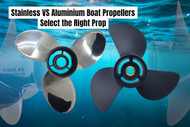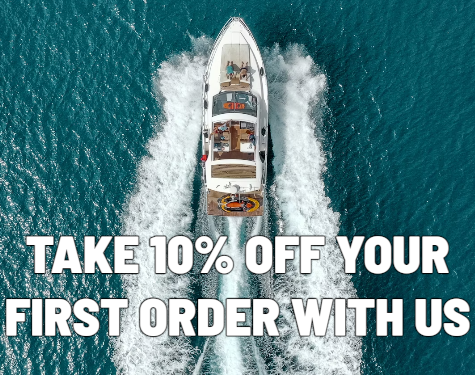Stainless vs Aluminium Boat Propellers
16th Oct 2025
Choosing the right boat propeller is crucial for optimal performance and fuel efficiency. Two of the most popular materials for propellers are stainless steel and aluminium. Each has distinct advantages and trade-offs that impact durability, cost, and performance. This comprehensive guide will help you understand the differences between stainless and aluminium boat propellers, so you can make an informed decision for your vessel.
Overview of Propeller Materials
Boat propellers are typically made from either stainless steel or aluminium, each offering distinct advantages depending on your boating needs. Aluminium propellers are the more economical option, known for their affordability and suitability for general-purpose boating and recreational activities. They are lighter than stainless steel and easier to repair if damaged, making them a popular choice for casual boaters. However, aluminium props tend to have thicker blades and are more prone to bending or damage, especially in rough or shallow waters.
On the other hand, stainless steel propellers provide superior strength and durability. They are harder and can maintain a more precise blade shape over time, which translates into better performance, improved acceleration, and higher top-end speeds. Stainless steel's resistance to corrosion also makes it ideal for harsher marine environments, such as saltwater boating. While stainless steel props come at a higher price point, their longevity and enhanced efficiency provide excellent value for performance-focused boaters or those who frequently navigate demanding conditions.
Ultimately, the choice between aluminium and stainless steel depends on your boat type, typical operating environment, budget, and performance expectations, allowing you to select the propeller material that best suits your marine adventures.
What Are Stainless Steel Propellers?
Stainless steel propellers are made from a corrosion-resistant alloy that is strong and durable. Due to the metal's robust nature, these propellers can be manufactured thinner and with more precise shapes, offering better performance and higher efficiency.
What Are Aluminium Propellers?
Aluminium propellers are more affordable and lighter than stainless steel options. They are softer material-wise and easier to repair if damaged, although they are less durable and prone to bending or denting.
Performance Comparison
Efficiency and Speed
Stainless steel propellers generally provide superior efficiency compared to aluminium due to their stronger material composition. The key factor lies in their ability to maintain sharper, more precise blade shapes over time, which significantly reduces drag as the propeller slices through the water. This improved hydrodynamic efficiency allows boats outfitted with stainless steel props to achieve higher top-end speeds and better overall acceleration. Aluminium propellers, while lighter and initially adequate, tend to wear down more quickly in demanding conditions, causing their blades to lose shape and increase drag, which can reduce speed and performance.
Thinner blades on stainless steel props also contribute to better water flow and reduced resistance, helping the engine reach its optimal RPM with less effort. When a propeller moves smoothly through water, less engine power is wasted overcoming water resistance, translating directly into improved speed and smoother handling.
Power and Fuel Economy
The inherent strength of stainless steel enables these propellers to transmit engine power more effectively to the water. Their stiffness means they flex less under load, allowing the engine's power output to convert into thrust more efficiently. This efficient power transfer results in better fuel economy because the engine doesn't need to work as hard to achieve cruising speeds.
In contrast, aluminium propellers, due to their softer nature, are more prone to flex during operation especially under heavy loads at higher RPMs. This flexing reduces the prop’s pitch temporarily, meaning the engine’s power is not fully converted to propulsion. The result can be increased fuel consumption for the same speed and less responsive handling.
Additionally, stainless steel propellers handle impacts and underwater obstacles better without deforming, retaining their designed shape, which ensures consistent power delivery and longer-term savings on maintenance costs. For boaters who spend considerable time on the water or demand stronger performance, investing in stainless steel props can offer a tangible return in fuel savings and improved boat control.
Durability and Maintenance
Strength and Longevity
Stainless steel propellers are known for their exceptional hardness and strength, making them highly resistant to damage from underwater debris, rocks, and impacts. This durability means they maintain their shape and performance characteristics over a much longer lifespan, even in challenging marine environments like saltwater or shallow areas. Their robust construction withstands high torque and high-speed conditions without deforming, ensuring consistent, reliable thrust. In contrast, aluminium propellers, while lighter and more affordable, are softer and more prone to dings, dents, and bends when exposed to similar conditions. These damages can diminish propeller efficiency and negatively affect your boat’s handling and speed if left unchecked.
Repairability
Despite being more susceptible to physical damage, aluminium propellers offer the advantage of easier and more affordable repairs. Small dents or bends in aluminium blades can usually be fixed relatively quickly by marine repair specialists, allowing boaters to restore performance without the need for replacement. Stainless steel propellers, due to their hardness and structural integrity, typically require more specialised and costly repair services. Minor damages often require professional welding or blade replacement, leading to higher maintenance costs over time. However, because stainless steel props are less frequently damaged due to their strength, the repairs tend to be less frequent, balancing out the higher repair expense.
Cost Considerations
Initial Cost
Aluminium propellers usually have a significantly lower upfront cost compared to stainless steel options, making them a popular choice for budget-conscious boaters or as temporary replacements. The manufacturing process and materials allow aluminium props to cost as little as one-third of their stainless steel counterparts. For recreational boaters or those with smaller engines, aluminium propellers offer good performance without a large financial commitment, which makes them ideal for casual use or as spares onboard.
Long-Term Investment
While stainless steel propellers require a higher initial investment, their exceptional durability and performance advantages can make them more cost-effective in the long run. Stainless steel’s superior strength allows for thinner blades that maintain their shape and efficiency over many years, leading to improved fuel economy and better boat handling. Frequent use in challenging conditions can cause aluminium props to deform, resulting in more frequent repairs or replacements, which add to ongoing costs. Investing in stainless steel often pays off through fewer replacements, reduced maintenance, and enhanced engine performance—providing better value to boaters who prioritise longevity and efficiency.
In summary, aluminium propellers are the economical choice upfront, suited to lighter use or smaller boats, while stainless steel props with their higher durability and performance serve as a worthwhile long-term investment for serious boaters.
Choosing the Right Propeller for Your Boat
Evaluate Your Boating Style and Environment
Selecting the ideal propeller starts with considering how and where you use your boat. For high-performance boats or frequent boating activities, investing in a stainless steel propeller is often worthwhile due to its superior durability and efficiency, which supports faster speeds and enhanced handling in demanding conditions. Stainless steel props excel on saltwater and rough terrains where impact resistance is crucial. Conversely, for casual, occasional boating or smaller vessels, aluminium propellers offer an excellent balance of affordability and functionality. They are lightweight, easier to repair, and effective for everyday recreational use without the higher upfront cost of stainless steel.
Consider Your Engine Type and Size
Matching your propeller’s material and specifications to your engine’s horsepower and boat size is essential to achieve optimal performance. A propeller must enable the engine to operate within its recommended wide-open throttle (WOT) RPM range to prevent over-revving or under-utilisation of power. Larger engines with higher horsepower can typically handle larger or higher-pitch stainless steel propellers, which can deliver better thrust and fuel efficiency. Smaller engines or boats designed for slower speeds often work best with lighter, lower-cost aluminium props that require less power to turn efficiently. Ensuring the right diameter, pitch, blade number, and material harmonise with your engine and hull design will maximise speed, fuel economy, and overall boating experience.
Choosing the right propeller, considering boating style, environment, engine power, and boat dimensions, ensures safer, more efficient, and enjoyable time on the water.
Additional Resources
See our detailed Guide to Boat Propellers for help choosing the perfect propeller.
Explore our range of marine hardware and accessories to fully equip your vessel.
For official boating safety information, visit the Australian Maritime Safety Authority (AMSA) website.
Frequently Asked Questions
Can I switch from aluminium to stainless steel propellers?
Yes, you can switch from aluminium to stainless steel propellers, but it’s important to ensure the new stainless steel propeller matches your engine’s specifications for pitch and diameter to maintain proper performance and avoid engine strain.
Are stainless steel propellers heavier than aluminium?
Stainless steel propellers are slightly heavier, but their design allows for thinner blades, which offsets some of the weight difference. This means the overall performance benefit often outweighs the minimal weight increase.
How often should I inspect my propeller?
It’s best to inspect your propeller regularly, especially after hitting underwater debris or boating in rough conditions. Even minor damage can affect efficiency and cause engine strain.
Do stainless steel propellers corrode in saltwater?
Stainless steel is highly corrosion-resistant, making it an excellent choice for saltwater boating. However, regular maintenance, including rinsing with fresh water after saltwater exposure, helps prevent corrosion and extends propeller life.
Is it difficult to repair stainless steel propellers?
Repairing stainless steel propellers can be more complex and costly than aluminium repairs, often requiring professional welding or blade replacement. However, stainless steel’s durability usually reduces the frequency of repairs needed.
Will a stainless steel propeller improve my boat’s performance?
Generally, yes. Stainless steel props have thinner, stronger blades that create less drag, offering improved acceleration, higher top speeds, and better fuel efficiency compared to aluminium.
Are aluminium propellers suitable for all water conditions?
Aluminium propellers are best for calm, sandy, or smooth waterways and are economical choices for casual boaters. However, they may bend or get damaged easily in rocky or debris-filled environments.
Can the propeller material affect fuel consumption?
Yes, stainless steel propellers often improve fuel economy by delivering power more efficiently with less flex and drag, resulting in lower engine effort to maintain speed.
How do I know the right propeller size and pitch for my engine?
Refer to your engine manufacturer’s specifications and consult a propeller fit guide to match the diameter, pitch, and material to your engine’s horsepower and your boat’s hull type for optimal performance.

 Australian Dollars
Australian Dollars

